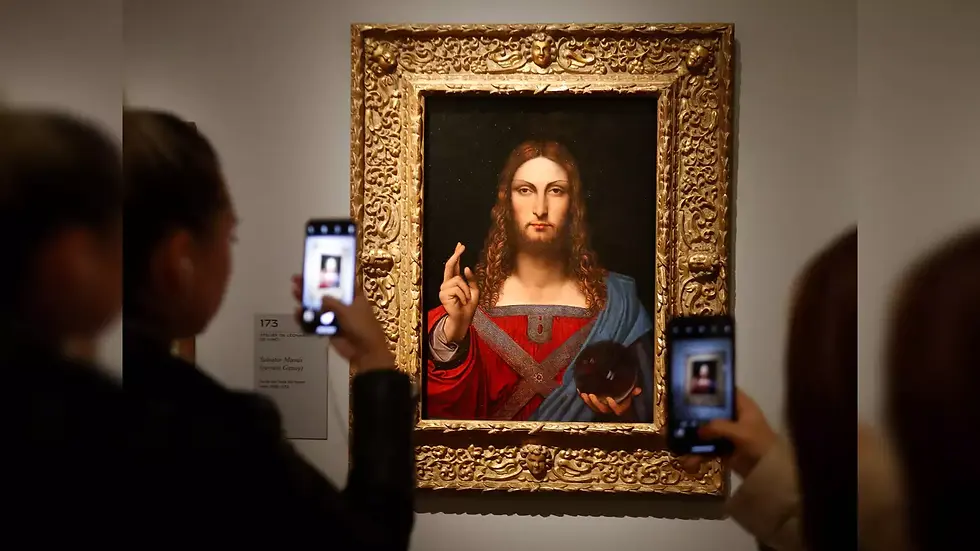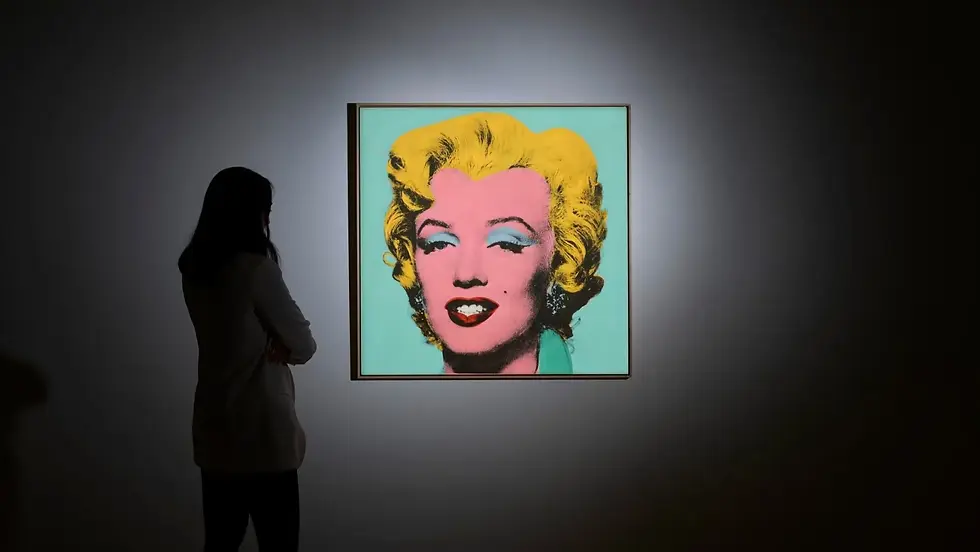The Most Expensive Art Pieces I 2025
- belart-gallery
- Dec 18, 2024
- 6 min read
Updated: Feb 10

What’s the Most Expensive Art in 2025?
Art isn’t just about beauty—it’s a timeless connection to history and creativity. As the art world evolves, so does the value of its most treasured masterpieces.
Until 2025, record-breaking sales and revaluations of iconic works like Salvator Mundi and Interchange continue to redefine the art market.
But what makes these pieces so valuable? what makes a painting worth hundreds of millions?
Let’s explore the most expensive art pieces in 2025, the stories behind them, and the factors driving their ever-growing worth.
1. Mona Lisa by Leonardo da Vinci | $1 billion

The Mona Lisa remains the most coveted piece for Western art. The Renaissance masterpiece isn't up for sale and experts have valued the painting at more than 1 billion dollars, taking into account the unrivalled importance in both historical and cultural context. The painting is located at the Louvre is the most famous painting around the globe, attracting millions of tourists each year.
Did You Know? If the Mona Lisa were ever auctioned, bidding could exceed even its theoretical valuation, given its unparalleled legacy.
2. Salvator Mundi by Leonardo da Vinci | $480 million

The piece was sold at $450.3 million in the year 2017, Salvator Mundi is still the highest-priced artwork that has ever been that was auctioned off. Its representation of Christ with a crystal orb shows the artist's skill in the way he melded realism and spirituality. The debate over its authenticity hasn't diminished its worth, with experts anticipating its worth to climb even higher by 2025.
What Makes It Special? Few paintings can match the intrigue of Salvator Mundi’s rediscovery and subsequent journey to becoming a global phenomenon.
3. Young Man Holding a Roundel by Sandro Botticelli | $475 million

Botticelli's Young Man with the Roundel set records when it was used in private talks in 2025 it became one of the top-priced Renaissance painting. Its precise detail and the significance of its historical context make the painting a unique work from one of the greatest Renaissance masters.
Fun Fact: Botticelli’s delicate rendering of the roundel intertwines portraiture with symbolic storytelling, elevating its artistic importance.
4. Interchange by Willem de Kooning | $320 million

This abstract expressionist masterpiece was valued at 320 million by 2025. Created in1955, Interchange marked the artist's transformation to vibrant compositions in abstract style. The powerful and high energy brushstrokes, as well as the bold color palette makes it among the most sought-after modern artworks.
Did You Know? Billionaire Kenneth C. Griffin’s purchase of Interchange in 2015 remains one of the defining moments in art market history.
5. Nafea Faa Ipoipo (When Will You Marry?) by Paul Gauguin | $310 million

Gauguin's vibrant portrayal of Tahitian women has continued to capture the interest of those who love art.
It was privately sold at $210 million in 2015 It's currently estimated to be $310 million.
This reflects its richness in culture as well as Gauguin's influence on contemporary art.
What Makes It Special? The painting is celebrated for its exotic themes and revolutionary use of color, which paved the way for Expressionism.
6. Number 17A by Jackson Pollock | $225 million

Pollock's 17A shows his distinctive drip technique that blends chaotic and controlled on the canvas. The complex layering techniques and bright color scheme earned it the price of the sum of $200 million during the private sale of 2016. It is estimated to have a value of $225 million in 2025.
Fun Fact: Pollock’s abstract expressionist works remain some of the most sought-after modern art pieces in the world.
7. The Card Players by Paul Cézanne | $275 million

Purchased by Qatar’s royal family for $250 million in 2011, Cézanne’s serene depiction of Provençal men playing cards continues to gain value.
For Cubism and modern art cements? its place and influence are among the most valuable paintings.
Did You Know? This painting is part of a series that offers a meditative glimpse into Cézanne’s evolving style.
8. Les Femmes d’Alger (Version O) by Pablo Picasso | $190 million

This vivid Cubist work reveals Picasso's obsession with color, form, and feminine figures. It was sold at $179.4 million in 2015. it's currently estimated as $190 million.
Its intricate nature and significance in the past keeps it highly sought-after for collectors.
What Makes It Unique? It’s part of a 15-piece series inspired by Eugène Delacroix’s Women of Algiers in Their Apartment.
9. Portrait of Adele Bloch-Bauer II by Gustav Klimt | $165 million

It was purchased for $150 million back during 2006, Klimt's extravagant depiction of Austrian socialite Adele Bauer is the apex the apex of Klimt's "Golden Period."
Its elaborate patterns and bright colors make it one of the most revered works in the history of art.
Did You Know? Legal battles over its ownership added to its fame, making it a symbol of art restitution.
10. The Scream by Edvard Munch |$135 million

Munch's famous depiction of angst, you can feel this master piece aren’t you sir? even if you were a child, its existential despair is one of the most famous images in the history of art.
The painting was auctioned off at $119.9 million back in the year 2012 its undiluted emotional impact continues to reverberate and drive its worth up to new levels to 2025.
What Makes It Iconic? Its universal themes of anxiety and despair transcend time, making it a cultural touchstone.
What Drives the Price of the Most Expensive Art Pieces?

A variety of factors influence the staggering value of these masterpieces.
1. Artist Reputation and Legacy
The works of famous artists such as Leonardo da Vinci, Pablo Picasso and Claude Monet command higher prices because of their unrivalled impact on the art world.
2. Rarity
The rarity of paintings, either due to its low production capacity or unique features--may significantly affect its worth.
3. Provenance
An extensive ownership history that includes being a included in royal collections or museums, enhances an item's value.
4. Cultural Significance
Artworks that represent movement (e.g., Renaissance, Impressionism, Abstract Expressionism) or depict historical events are of enormous value.
5. Auction Dynamics
The most high-profile auctions usually trigger intense bidding wars between collectors with wealth and can drive prices up exponentially.
The Evolution of Art Valuation: From Renaissance to NFTs

While traditional paintings are the upper echelon, contemporary fashions are changing the nature of the market for art. Digital art's rise as well as the rise of NFTs (non-fungible tokens) is introducing new ways to evaluate the art of creativity. In 2021 “Beeple's Everyday: The First 5000 Days” was sold at a price of $69 million. It highlighted the possibility of digital art as a rival against traditional works.
How Do NFTs Compare to Traditional Art?
• Accessibility: The NFT principles democratize ownership of art and allow collectors around the world to make investments digitally.
• Preservation: Digital formats eliminate concerns about physical degradation.
• Value Dynamics As NFT's popularity increased, classic art works like Pollock's work or da Vinci's work are timeless.
FAQs About the Most Expensive Art in the World
What's the highest-priced art work ever purchased?
Salvator Mundi by Leonardo da Vinci, sold at $450.3 million last year is the record for this auction.
What does The Mona Lisa worth?
Why do certain artworks so costly?
What's the highest priced abstract art?
The Timeless Value of Art
From the intriguing smile of Mona Lisa to the dazzling chaos that is Pollock's Number 17A the most costly art works highlight the art's unique capability to reach out to humanity. They transcend the realm of money and serve as cultural landmarks which connect the past with the present. The art world is constantly evolving yet one element remains the same that of the immense value of art and its effect on our history.
Do you want to spend millions, or perhaps billions of dollars to own an item of historical significance?

































